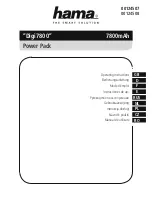
ENGLISH
en
13
Caution.
Risk of material damage
4.12 Symbols on the air tool
Read the operating instructions before
starting to use the machine.
Wear safety goggles.
Wear ear protectors.
Direction of rotation
See page 2.
1 Sanding head
2 Clamp screw for adjusting sanding head
3 Auxiliary handle
4 Switch (on/off)
5 Switch-on lock
6 Air outlet
7 Compressed air connection with filter
8 Plug-in nipple 1/4"
9 Adjusting screw for setting the speed
10 Rotary knob for securing the sanding
attachment and adjusting the belt run
11 Tensioner arm for replacing the sanding belt
12 Sanding attachment
13 Sanding belt*
14 Screw for securing the cover
15 Arrow (direction of rotation of drive shaft)
16 Cover
* depending on features/not in scope of delivery
6.1 Before using the tool for the first time
Insert plug-in nipple (8).
6.2 Attaching the additional handle
Always work with the auxiliary handle attached
(3)! Screw in the auxiliary handle firmly.
6.3 Turning the sanding head (1) to operat-
ing position
Loosen the clamp screw (2) using the hexagon
spanner and, if necessary and depending on the
task at hand, turn the sanding head (1). The sanding
head must be positioned in the permitted working
area as shown (see illustration A, page 2).
Firmly tighten the clamp screw (2).
Before you start work, always verify that the
clamp screw (2) is sufficiently tightened to
ensure that the sanding head (1) does not move.
Otherwise, the sanding belt (13) may come in
contact with the user. Loss of control can cause
personal injury.
6.4 Sanding belt replacement
See illustration B, page 2.
- Manually loosen screw (14) and remove cover
(16).
- Pull tensioner arm (11) backwards and remove
sanding belt (13).
- Place the new sanding belt on the rollers such that
its direction of circulation (arrows on the inside of
the sanding belt) matches the arrows (15) on the
cover. Place the sanding belt first on the drive
shaft and then on the roller on the sanding attach-
- Replace the cover (16) and tighten the screw (14)
by hand.
- Check the belt run and adjust if necessary (see
Section 6.5).
6.5 Adjusting belt run
Disconnect the air tool from the compressed
air supply. Using the screw (10), adjust the
sanding belt - while the machine is not in operation
- so that the belt runs along the centre of the sanding
belt roller.
6.6 Sanding procedure
Switch the machine on first before mounting it on
the workpiece.
Place the machine on the material such that the
sanding belt is parallel to the surface of the work-
piece.
Keep the machine in constant motion: otherwise
indentations could be produced in the material.
6.7 Replacing the sanding attachment
See illustration C, page 2.
- Removing the sanding belt (see Section 6.4).
- Remove screw (10), and remove sanding attach-
- Attach the other sanding attachment as shown
(ensure that the nose at the end of the sanding
attachment is pointing in the direction of the
tensioning arm; see illustration C).
- Secure with screw (10).
- Attaching the sanding belt (see Section 6.4).
- Adjusting the belt run (see Section 6.5).
6.8 Using the air tool
Always guide the machine with both hands.
Switch the machine on first before mounting it
on the workpiece.
After switching off the machine, only set it
down when the motor has come to a standstill.
To benefit from the air tool's full performance,
always use compressed air hoses with an inner
5. Overview
6. Operation
10
Summary of Contents for DBF 457
Page 2: ...2 A B C 1 6 2 3 4 5 7 10 11 12 13 14 15 16 10 12 8 9...
Page 57: ...ru 57 1 2 3 4 3 4 1 1 2 3 4...
Page 58: ...ru 58 4 2 4 3 4 4 4 5 4 6 4 7...
Page 59: ...ru 59 4 8 4 9 4 10 Whipcheck 4 11...
Page 60: ...ru 60 Metabo P2 30 4 12 2 1 2 3 4 5...
Page 69: ......
Page 70: ......
Page 71: ......
Page 72: ...Metabowerke GmbH Metabo Allee 1 72622 Nuertingen Germany www metabo com 170 27 2730 1115...














































